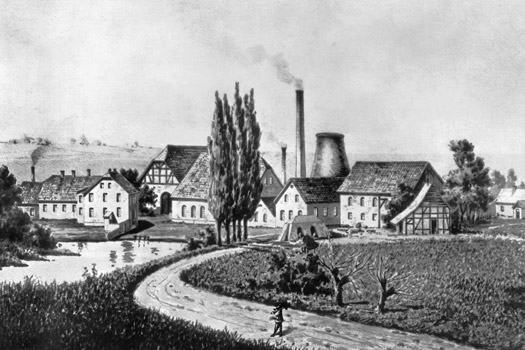
Der Kokshochofen der St.-Antony-Hütte
Studienreisen nach Oberschlesien ermöglichten 1842 auf der Osterfelder St. Antony-Hütte den Bau eines ersten Kokshochofens im heutigen Ruhrgebiet.
© LVR-Industriemuseum, Oberhausen
Kapital zurück zur Auswahl
The St. Anthony Ironworks coke furnace
A Silesian style blast furnace
Five masons worked on the St. Anthony Ironworks in Osterfeld during the entire summer of 1842 in order to construct a technical innovation from 300,000 bricks. In existence since 1758, it was the oldest ironworks in the area, and had since then been known for its large coke furnaces. Nevertheless the new construction of a furnace in 1842 was apparently noteworthy enough that Pastor Johannes Terlunen noted in his congregational chronicles that the new oven could be used with coke, or wood charcoal; wood charcoal had, until then, been the only thing used. This coke furnace may have reached a height between 13 and 16 meters and sat on a surface of nearly 12 by 12 meters; because no images have survived its height and its approximate appearance can only be derived with the aid of comparable, contemporary blast furnaces.
Drawings and pictures of suitable, comparable blast furnaces have survived from Upper Silesia; but why look at this particular iron-producing region? Around 1840 the St. Anthony coke furnace planned the “Hüttengewerkschaft und Handlung Jacobi, Haniel & Huyssen (JHH)”, which was later known as the global corporation “Gutehoffnungshütte (GHH)” in today’s Oberhausen. The “know-how” for the furnace project had been outwardly sought since the 1830’s: the JHH ironworks engineer, Friederich Kesten, had brought back method descriptions from his travels through Upper Silesia for a long time, because, unlike the region along the Ruhr, the region of Upper Silesia had collected experience with coke smelting since 1789. Kesten’s travel notes contain a sketch of a blast furnace that resembles that of the archaeological find at St. Anthony.
But the project of constructing a “Silesian style” coke furnace failed due to the upcoming sales crisis of 1842, the St. Anthony ironworks’ bad location, and lastly, perhaps most notably, due to its lack of detailed knowledge: the oven was never given a special fire-proof lining to protect from the high temperatures of the coke fire. Around 1854 it was torn down, unused, because it stood in the way of the expansion of the foundry; after 1842 no more iron was smelted in St. Anthony. A much larger JHH coke furnace was put into operation in 1855 next to the Cologne-Mindener railway. The St. Anthony ironworks, where smelting operations ceased in 1877, can be viewed today as an outpost of the LVR Industry Museum.
Denkmale zum Impuls
Oberhausen - St. Antony-Hütte
Die St. Antony-Hütte ging als älteste Eisenhütte der Region bereits 1758 in ... weiter

